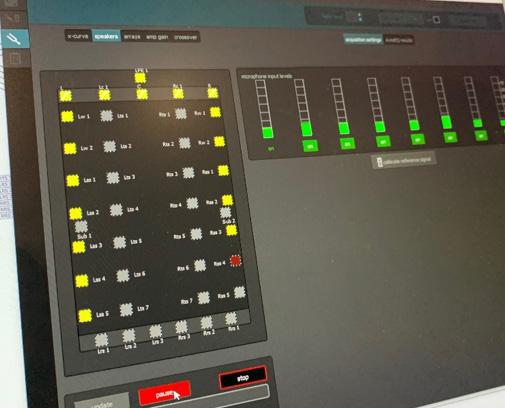
3 minute read
Audio design: how to achieve aural nirvana in your cinemas’ auditoria
Audio design: how to achieve aural nirvana
Advertisement
processor is fed properly to the amp
Darren Briggs considers the marriage of sound waves, amps and volts that delivers the perfect experience in your cinema.
WHEN SPECIFYING A cinema sound system, there is more to it than simply picking a loudspeaker and amplifier. The size of the room directly relates to the volume of air within the auditorium that is required to be moved by the speaker to create the sound. As sound is transferred by waves of air moving in the auditorium, it is the loudspeaker’s job to move the air that vibrates your ear drum.
An underpowered system won’t be able to push enough air to reach the required volume in the auditorium. Hence you see some very large speakers in big auditoriums and in the smaller auditoriums, less air by volume needs to be moved, so use of smaller speakers is possible.
In turn, the amplifier provides the voltage to power the speaker. A 2,000W sub bass speaker when driven hard (2,000W peak power) can be sent around 125volts at 16amps (hence it will need a larger specification speaker cable!). If the amplifier cannot provide such power, the speaker will simply be too quiet. On the flip side, if the amplifier provides too high a voltage and current to an under-powered speaker, then the speaker will fail. A typical stage speaker will be running from around 0.5volts to 5volts at around 1amp. This will be dependent on the content screened. A speaker’s power rating is the first consideration when specifying a sound system, closely followed by the correct power amplifier to drive the speaker.
THERE ARE VARIOUS tools to help specify loudspeakers and amplifiers, ensuring they are matched to avoid clipping, distortion and even damage — all whilst providing sufficient power for the high-quality audio produced by the Digital Cinema system.
Once the system is specified, it still has to be configured correctly by the engineer. Our job is to ensure the audio signal from the cinema processor is fed correctly to the amplifier, maximising the limits of the line level signal.
If we overload an amplifier with too high a signal, this could cause distortion and clipping. Too low a signal will result in having to turn the amplifier gain up increasing the chance of magnifying any noise from the source — this can result in a ‘hiss’ being heard. Not all amplifiers are of the same quality. Some may be inherently nosier or hissy than others, an effect you will notice especially in underpowered systems.

The gain structure is set in a specific way to maximise signal-to-noise ratios and to maximise equipment headroom. Engineers deploy specialist calibrated test tools and audio setup programs. These are used on the latest cinema processors to ensure sound is optimised for your auditorium. A crucial part of the setup, gain structure helps to maximise the perfect sound reproduction.
Digital soundtracks have a large dynamic range, so headroom is required in the signal path and equipment to allow reproduction of these large peaks in volume. We often find sites with older sound systems made for analogue film suffer without upgrades to cope with the larger dynamic range of digital — a serious consideration if you want to give your audience the best experience.
Gain structure helps to maximise the perfect sound and is a crucial part of your setup
Above, 7.1 EQ user interface; below, the EQ for the Dolby Atmos system




